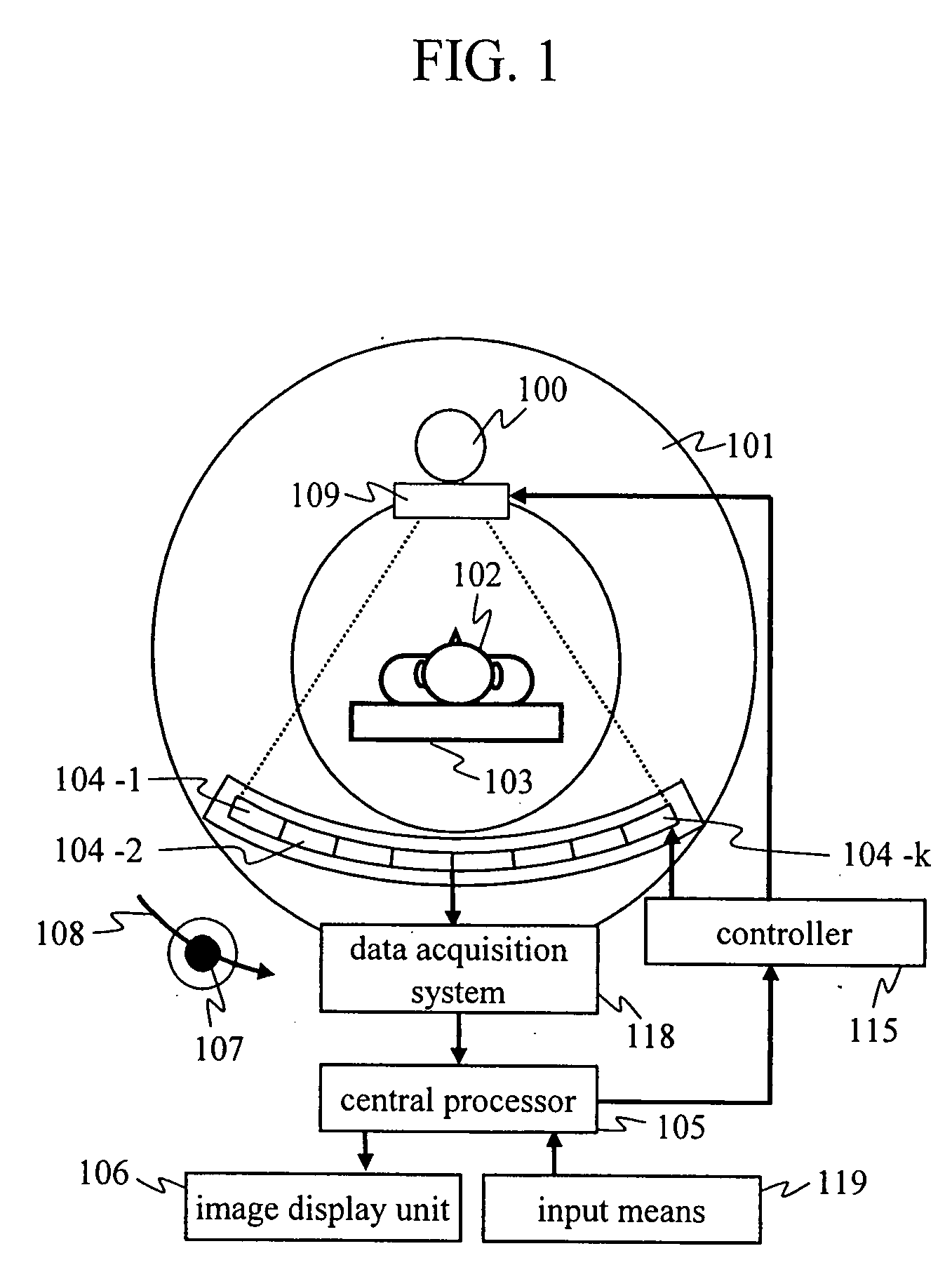Semiconductor radiation detector with guard ring, and imaging system with this detector
a technology of electromagnetic radiation detector and guard ring, which is applied in the field of electromagnetic/xray imaging system, can solve the problems of difficult realization of guard ring at the end portions of each x-ray detecting region, inability to read signals from x-ray detecting elements in the x-ray detecting region separately, and inability to obtain signals incident between the x-ray detecting elements, etc., to achieve the effect of reducing noise, expanding dynamic range and increasing snr
- Summary
- Abstract
- Description
- Claims
- Application Information
AI Technical Summary
Benefits of technology
Problems solved by technology
Method used
Image
Examples
embodiment 1
[0053]The present embodiment relates to a medical X-ray CT scanner, which is an object to which the present invention is applied, and in the present embodiment, the position or the presence / absence of a guard-ring can be changed in accordance with conditions of the imaging field of view (FOV). Embodiment 1 of the present invention will be described hereafter with reference to FIGS. 1 to 11.
[0054]FIG. 1 schematically shows an X-ray CT scanner of the present embodiment. FIG. 2 is an example of an X-ray detector mounted on the X-ray CT scanner of FIG. 1. FIG. 3 shows the configuration of pixel electrodes and guard-ring electrodes formed on a distribution module 113. FIGS. 4 and 5 show an example of electric lines of the pixel electrodes and an example of electric lines of the guard-ring electrodes, respectively. FIGS. 6 and 7 show cross-sectional views taken along position A of FIGS. 2 and 3, and the figures show the difference in electric field, depending on the presence or absence of...
embodiment 2
[0075]An X-ray CT scanner of the present embodiment is the same as that described with FIG. 1 in Embodiment 1, and the structure of the X-ray detector 104 is also the same as that described with FIG. 2 in Embodiment 1. FIG. 12 shows an example of the configuration of the guard-ring electrodes of the X-ray detector 104 according to the present embodiment. FIG. 13 shows an example of electric lines of the guard-ring electrodes of FIG. 12. The X-ray CT scanner of the present embodiment comprises a function (binning) of adding signals from adjacent X-ray detecting elements and is capable of changing the position or the presence / absence of the guard rings, depending on binning conditions. FIG. 14 and FIG. 15 show cross-sectional views explaining the appearance of electric fields when the binning is present and absent.
[0076]Hereafter, as one example of imaging conditions involving different kinds of binning, no-binning imaging in which binning is not conducted, and two-pixel binning imagi...
embodiment 3
[0086]An X-ray CT scanner of the present embodiment is the same as that shown in FIG. 1 described in Embodiment 1. Based on the X-ray CT scanner in Embodiment 2, while the interelement guard-ring electrodes 111 are not connected to the readout circuit, in the present embodiment, the interelement guard-ring electrodes 111 can be connected to the readout circuit, and switching between the connection to ground potential and the connection to the readout circuit is made possible, depending on binning conditions.
[0087]Based on the X-ray CT scanner of the present embodiment, when the binning is not conducted, the interelement guard-ring electrodes 111 are connected to ground potential. In contrast, when the binning is conducted, the interelement guard-ring electrodes 111 are connected to the readout circuit in the data acquisition system 118. FIG. 18 shows an example of the processing of the data acquisition system 118 in such case. As shown in FIG. 18, the output signals from the pixel e...
PUM
 Login to View More
Login to View More Abstract
Description
Claims
Application Information
 Login to View More
Login to View More - R&D
- Intellectual Property
- Life Sciences
- Materials
- Tech Scout
- Unparalleled Data Quality
- Higher Quality Content
- 60% Fewer Hallucinations
Browse by: Latest US Patents, China's latest patents, Technical Efficacy Thesaurus, Application Domain, Technology Topic, Popular Technical Reports.
© 2025 PatSnap. All rights reserved.Legal|Privacy policy|Modern Slavery Act Transparency Statement|Sitemap|About US| Contact US: help@patsnap.com



